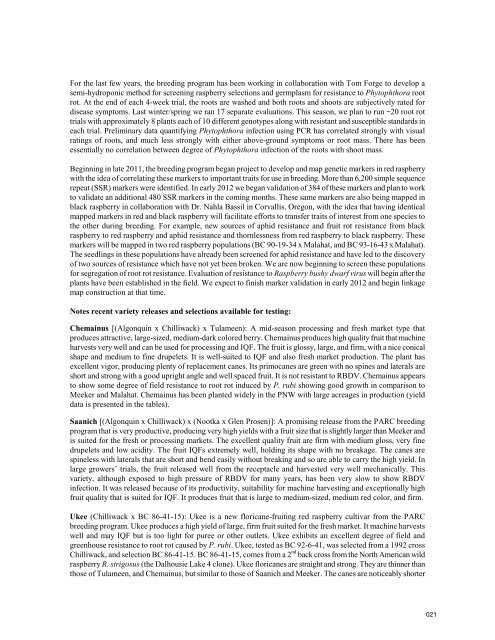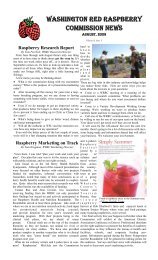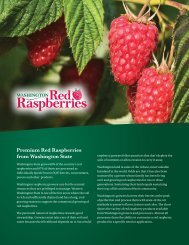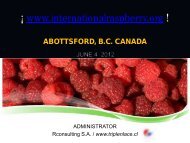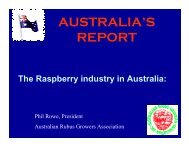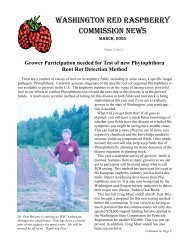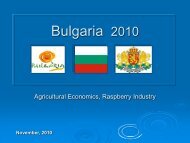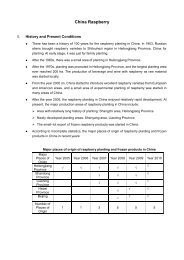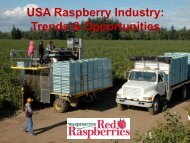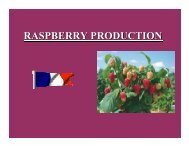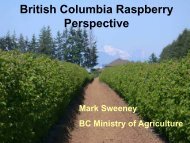2012 - Washington Red Raspberry Commission
2012 - Washington Red Raspberry Commission
2012 - Washington Red Raspberry Commission
Create successful ePaper yourself
Turn your PDF publications into a flip-book with our unique Google optimized e-Paper software.
For the last few years, the breeding program has been working in collaboration with Tom Forge to develop a<br />
semi-hydroponic method for screening raspberry selections and germplasm for resistance to Phytophthora root<br />
rot. At the end of each 4-week trial, the roots are washed and both roots and shoots are subjectively rated for<br />
disease symptoms. Last winter/spring we ran 17 separate evaluations. This season, we plan to run ~20 root rot<br />
trials with approximately 8 plants each of 10 different genotypes along with resistant and susceptible standards in<br />
each trial. Preliminary data quantifying Phytophthora infection using PCR has correlated strongly with visual<br />
ratings of roots, and much less strongly with either above-ground symptoms or root mass. There has been<br />
essentially no correlation between degree of Phytophthora infection of the roots with shoot mass.<br />
Beginning in late 2011, the breeding program began project to develop and map genetic markers in red raspberry<br />
with the idea of correlating these markers to important traits for use in breeding. More than 6,200 simple sequence<br />
repeat (SSR) markers were identified. In early <strong>2012</strong> we began validation of 384 of these markers and plan to work<br />
to validate an additional 480 SSR markers in the coming months. These same markers are also being mapped in<br />
black raspberry in collaboration with Dr. Nahla Bassil in Corvallis, Oregon, with the idea that having identical<br />
mapped markers in red and black raspberry will facilitate efforts to transfer traits of interest from one species to<br />
the other during breeding. For example, new sources of aphid resistance and fruit rot resistance from black<br />
raspberry to red raspberry and aphid resistance and thornlessness from red raspberry to black raspberry. These<br />
markers will be mapped in two red raspberry populations (BC 90-19-34 x Malahat, and BC 93-16-43 x Malahat).<br />
The seedlings in these populations have already been screened for aphid resistance and have led to the discovery<br />
of two sources of resistance which have not yet been broken. We are now beginning to screen these populations<br />
for segregation of root rot resistance. Evaluation of resistance to <strong>Raspberry</strong> bushy dwarf virus will begin after the<br />
plants have been established in the field. We expect to finish marker validation in early <strong>2012</strong> and begin linkage<br />
map construction at that time.<br />
Notes recent variety releases and selections available for testing:<br />
Chemainus [(Algonquin x Chilliwack) x Tulameen): A mid-season processing and fresh market type that<br />
produces attractive, large-sized, medium-dark colored berry. Chemainus produces high quality fruit that machine<br />
harvests very well and can be used for processing and IQF. The fruit is glossy, large, and firm, with a nice conical<br />
shape and medium to fine drupelets. It is well-suited to IQF and also fresh market production. The plant has<br />
excellent vigor, producing plenty of replacement canes. Its primocanes are green with no spines and laterals are<br />
short and strong with a good upright angle and well spaced fruit. It is not resistant to RBDV. Chemainus appears<br />
to show some degree of field resistance to root rot induced by P. rubi showing good growth in comparison to<br />
Meeker and Malahat. Chemainus has been planted widely in the PNW with large acreages in production (yield<br />
data is presented in the tables).<br />
Saanich [(Algonquin x Chilliwack) x (Nootka x Glen Prosen)]: A promising release from the PARC breeding<br />
program that is very productive, producing very high yields with a fruit size that is slightly larger than Meeker and<br />
is suited for the fresh or processing markets. The excellent quality fruit are firm with medium gloss, very fine<br />
drupelets and low acidity. The fruit IQFs extremely well, holding its shape with no breakage. The canes are<br />
spineless with laterals that are short and bend easily without breaking and so are able to carry the high yield. In<br />
large growers’ trials, the fruit released well from the receptacle and harvested very well mechanically. This<br />
variety, although exposed to high pressure of RBDV for many years, has been very slow to show RBDV<br />
infection. It was released because of its productivity, suitability for machine harvesting and exceptionally high<br />
fruit quality that is suited for IQF. It produces fruit that is large to medium-sized, medium red color, and firm.<br />
Ukee (Chilliwack x BC 86-41-15): Ukee is a new floricane-fruiting red raspberry cultivar from the PARC<br />
breeding program. Ukee produces a high yield of large, firm fruit suited for the fresh market. It machine harvests<br />
well and may IQF but is too light for puree or other outlets. Ukee exhibits an excellent degree of field and<br />
greenhouse resistance to root rot caused by P. rubi. Ukee, tested as BC 92-6-41, was selected from a 1992 cross<br />
Chilliwack, and selection BC 86-41-15. BC 86-41-15, comes from a 2 nd back cross from the North American wild<br />
raspberry R. strigosus (the Dalhousie Lake 4 clone). Ukee floricanes are straight and strong. They are thinner than<br />
those of Tulameen, and Chemainus, but similar to those of Saanich and Meeker. The canes are noticeably shorter<br />
021


